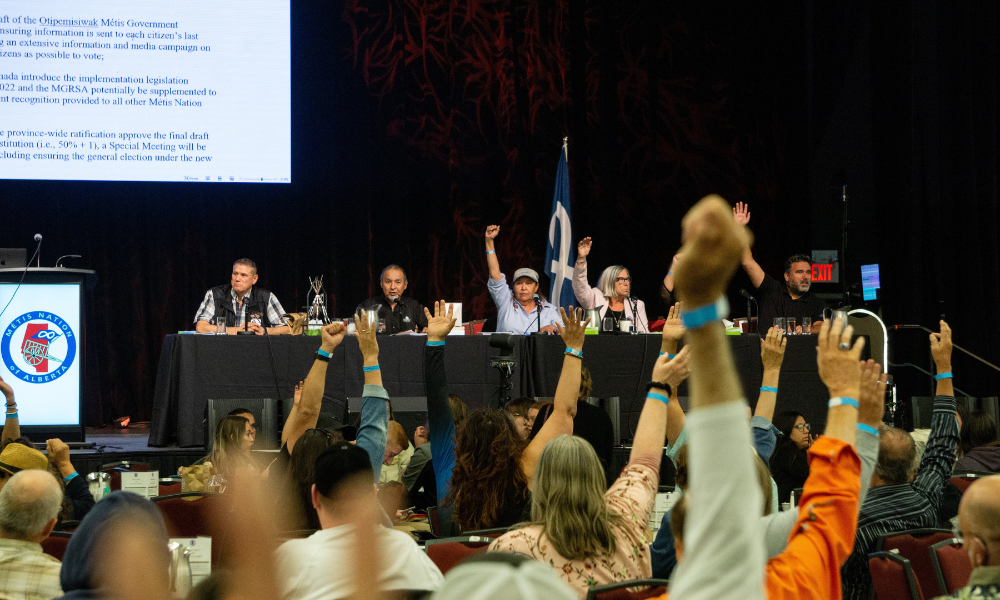
Court wins over last two decades paved the way for self-determination, says lawyer

Throughout the month of November, citizens of the Metis Nation of Alberta (MNA) will vote to ratify its constitution, the final leg in the path to self-government.
Ratification requires a vote of 50 percent plus one, and more than 50,000 MNA citizens are eligible for the vote, which concludes Nov. 30.
In 2019, the MNA and the federal government signed the Metis Government Recognition and Self-Government Agreement, which affirmed the MNA’s inherent right of self-government, and set out the process for recognition of an MNA constitution. That year, Canada also signed self-government agreements with the Metis Nations of Ontario and Saskatchewan, and in 2021, signed one with the Manitoba Metis Federation. Canada has entered 25 self-government agreements with 43 Indigenous communities across Canada.
“It is all about all the work that our ancestors did, long before I was ever president, with a vision, a hope,” says MNA president Audrey Poitras. “When we look back, the vision has never changed. It was about recognition. It was always about recognition.”
“It's something that our people have dreamed about: a nation within a nation,” she says. “As Metis, we're still Albertans. We're still Canadians. That's how we live and work and play. And it's the recognition part, that we are one of the Indigenous people that have rights in this country, long before Alberta was Alberta. That's what we fight for, and I think we're almost there.”
Established in 1928, the MNA is 94 years old and has been operating since 1960 as an incorporated entity under Alberta’s Societies Act.
The MNA created a constitution commission which consulted with Metis communities across the province. The constitution has gone through three drafts and its current form was approved for the ratification process by around 800 MNA members.
Historically struggling to have their self-governing systems recognized by Canada, the Metis have fought for it successfully in the courts over the last two decades, says Jason Madden, legal counsel for the MNA and co-managing partner of Pape Salter Teillet LLP. This began with R. v. Powley in 2003, and continued with Alberta v. Cunningham in 2011, Manitoba Metis Federation Inc. v. Canada in 2013, and Daniels v. Canada in 2016.
“All of those cases have really been about trying to find the space for the Metis to be recognized as a distinct Indigenous people, and having their governments recognized as such,” he says.
“The Metis have built their own governance structures. The MNA is an example. 94 years old and has been operating itself as a government for many generations. But that recognition in Canadian law has always been the missing piece.”
To form governments, Metis have used legislation, like the Societies Act, intended for non-profit corporations.
“It's always been an awkward fit,” says Madden. “Those pieces of legislation are not designed to house Indigenous governments, in any way, shape, or form.”
The modern-day treaty-making process and the self-government agreement process allow Indigenous governments to establish constitutions and govern themselves, while being recognized by Canada. While Inuit and First Nations have had access to the Comprehensive and Specific Land Claims processes, the Metis have historically been excluded, he says.
That changed with the Daniels decision, which found the Metis are “Indians,” for the purposes of s. 91.24 of the Constitution Act, 1867, which gives the federal government the responsibility to engage in nation-to-nation, government-to-government relationships with Indigenous peoples.
The confluence of the Daniels decision and a new federal government pursuing reconciliation was the missing piece for the Metis, says Madden. The talks which led to the Metis Government Recognition and Self-Government Agreement began in 2015. Importantly, he says, the agreement recognizes that the Metis Nation within Alberta has “the inherent right of self-government.”
With approximately 50,000 eligible voters, the MNA’s is the largest constitutional ratification ever undertaken by an Indigenous Nation in Canada, he says.
The Otipemisiwak Métis Government constitution will give the MNA a new fiscal relationship with Canada, under which the MNA will design its own supports in health, housing language, education, training, economic development, and justice. The constitution establishes four branches of government: the Citizens’ Gathering, District Councils, the Citizens’ Council, and the Judicial Branch.
The Citizens’ Gathering will serve as a forum, convened each summer, where MNA citizens interact and consult with their elected representatives and come together for shared social, cultural, political, and spiritual activities. Various governmental institutions will provide reports, and citizens will have the opportunity to pose questions and give feedback.
The constitution divides Alberta into 22 districts, each of which may have a District Council, composed of an elected District Captain and Councillors. The Citizens’ Council will be a province-wide governing body, with a president, one Citizens’ Representative per district, one Women’s Representative, and one Youth Representative – all of whom will be elected every four years.
As to the Judicial Branch, the constitution states that the Otipemisiwak Metis Government “shall maintain one or more laws establishing one or more impartial bodies to decide and prescribe the resolution of disputes,” and address various other matters, including citizenship, elections, and the interpretation of laws.
“A lot of people talk about self-determination and the United Nations Declaration on the Rights of Indigenous people,” says Madden. “This is what it looks like in practice. Indigenous peoples deciding how they want to govern themselves and Canada, ultimately, recognizing those governments on their own terms, as opposed to imposing terms on them or prescribing how what that self-government needs to look like.”